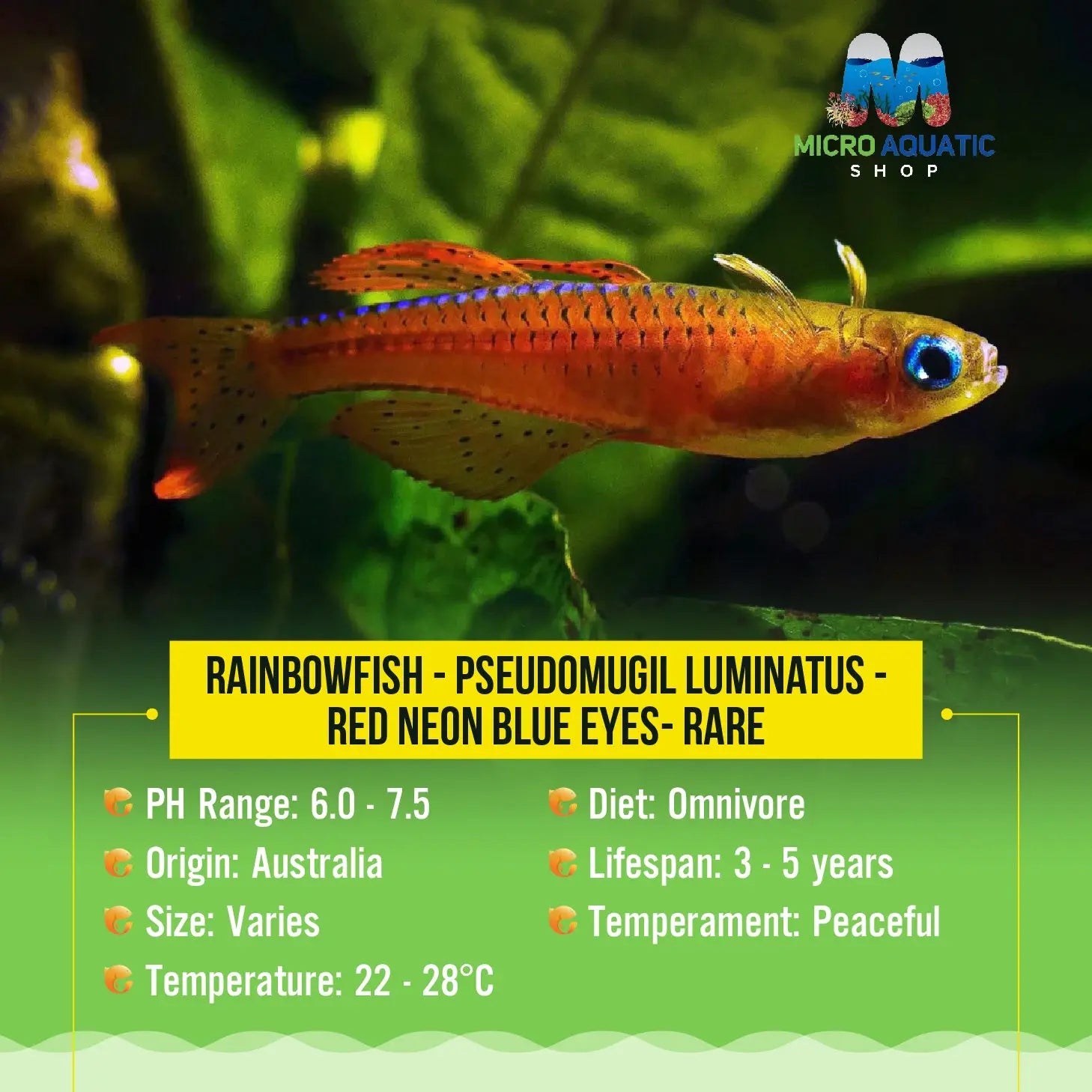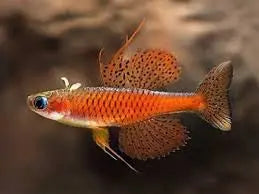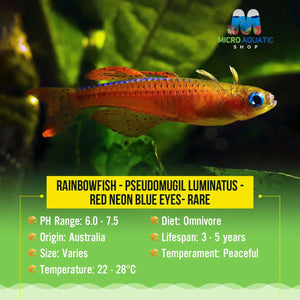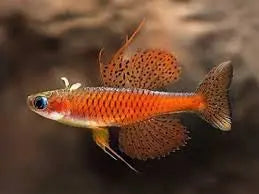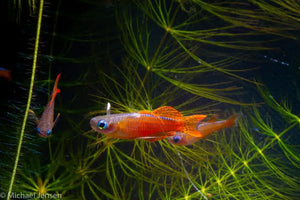Pseudomugil luminatus - Red Neon Blue Eyes- Rare
Guarantee Safe Checkout
Blue Eye Rainbowfish (Pseudomugil gertrudae) - Colorful Freshwater Fish
Aussie aquarium fans are always looking for vibrant fish to add to their tanks. The Blue Eye Rainbowfish, known as Pseudomugil gertrudae, is a favourite. It's known for its bright colours and elegant swimming, making it a standout in any tank.  The Blue Eye Rainbowfish comes from eastern Australia's coast. It's a visual treat with its blues, greens, and bright colours. Its popularity is growing as more people in Australia fall in love with its beauty and hardiness.
The Blue Eye Rainbowfish comes from eastern Australia's coast. It's a visual treat with its blues, greens, and bright colours. Its popularity is growing as more people in Australia fall in love with its beauty and hardiness.
Key Takeaways
- The Blue Eye Rainbowfish is a stunning native Australian freshwater fish known for its vibrant colours and graceful swimming.
- This species originates from the coastal regions of eastern Australia and has become a popular choice among aquarium enthusiasts.
- With its intricate patterns of blues, greens, and vibrant hues, the Blue Eye Rainbowfish can transform any freshwater aquarium into a captivating underwater oasis.
- The Blue Eye Rainbowfish is a hardy and adaptable species, making it a great choice for both novice and experienced aquarium hobbyists.
- As an Australian native, the Blue Eye Rainbowfish is a unique and fascinating addition to any freshwater fish collection.
Understanding the Blue Eye Rainbowfish (Pseudomugil Gertrudae)
The Blue Eye Rainbowfish is a hit among tropical fish fans in Australia. It's part of the Melanotaeniidae family. This fish is known for its bright colours and how well it fits into different aquariums.
Natural Habitat and Distribution
The Blue Eye Rainbowfish comes from northern Australia's coast. It loves the calm, slow waters of rivers, streams, and swamps. You can find them in the tropical north, from Western Australia's Kimberley to Queensland's Cape York Peninsula.
Physical Characteristics and Size
These fish are small and slender, growing up to 5 centimetres long. They live for about 2-3 years in tanks. Males are a sight to see, with their shimmering blues, greens, and yellows. Females are a bit more subtle, with silver and bronze colours.
Sexual Dimorphism
There's a clear difference between males and females of the Blue Eye Rainbowfish. Males are bigger and more colourful. They also have a more defined forehead and bigger fins. This makes them stand out from the smaller, more delicate females.
Setting Up the Perfect Aquarium Environment
To make a great home for your aquarium fish, you need to think about the tank size, water quality, and decorations. Let's explore the key steps to set up the best space for your Blue Eye Rainbowfish.
Tank Size and Water Parameters
Blue Eye Rainbowfish are small but lively. They do well in a 20-gallon tank. The water should be clean, with a pH of 6.5-7.5 and a temperature of 72-82°F. Keeping the water quality steady is important. You might want to get a good filter and change the water regularly.
Planting and Decorating
To mimic their natural home, add lots of plants. Choose Vallisneria, Cryptocoryne, and Java Fern for hiding spots. Then, add driftwood, rocks, and other decorations to make it look amazing and interesting.
Suitable Tank Mates
Blue Eye Rainbowfish are friendly and like to be with others. They get along well with small, calm fish like Glowlight Tetras, Pygmy Corydoras, and Dwarf Gourami. Stay away from big or aggressive fish that might bother them.  Plan well for the tank size, water, plants, and tank mates. This way, your Blue Eye Rainbowfish will have a beautiful place to live and show off their bright colours.
Plan well for the tank size, water, plants, and tank mates. This way, your Blue Eye Rainbowfish will have a beautiful place to live and show off their bright colours.
Feeding and Nutrition Requirements
To keep your aquarium fish healthy, like the Blue Eye Rainbowfish (Pseudomugil gertrudae), you need to focus on their diet. As fans of freshwater fish, we must give them a balanced diet. This helps them grow, stay colourful, and feel their best.
Preferred Foods and Feeding Regimen
Blue Eye Rainbowfish love to eat a variety of foods. Here's what we recommend:
- High-quality flakes or micro-pellets made for tropical fish
- Frozen or freeze-dried foods like brine shrimp, bloodworms, and daphnia
- Live foods, like micro-worms or small crustaceans, for fun and nutrition
- Blanched spinach or zucchini to meet their herbivorous needs
Feed them small meals often, not one big one. This keeps their digestive system healthy and their colours bright.
Maintaining Optimal Nutrition
Watching what your Blue Eye Rainbowfish eat is key to their health. Pay attention to how they react to different foods. Adjust their diet based on their preferences and needs. Also, keep their water clean and well-filtered to support their health.
| Nutrient | Recommended Levels |
| Protein | 40-50% |
| Fats | 5-10% |
| Carbohydrates | 20-30% |
Following these tips and adjusting their diet will help your Blue Eye Rainbowfish thrive. They'll stay healthy and show off their beautiful colours for a long time.
Breeding Guide for Blue Eye Rainbowfish
Breeding the Blue Eye Rainbowfish can be a rewarding hobby for aquarium lovers. We'll show you how to breed these colourful fish at home. It's a journey filled with excitement and learning. To start, create the perfect environment. You'll need a big tank with lots of plants and hiding spots. Soft water that matches their natural home is also key. Keeping the water's pH and temperature just right will help them breed. The Blue Eye Rainbowfish has special ways of breeding. They lay eggs in dense plants, which hatch quickly. Make sure your tank has fine-leaved plants for the eggs to settle in.
| Water Parameter | Ideal Range |
| pH | 6.5 - 7.5 |
| Temperature | 22°C - 26°C |
| Hardness | 5 - 15 dGH |
After the eggs are laid, they need the right conditions to hatch. Keep the water stable and clean. This way, the fry will grow strong and healthy. By following this guide, you can raise a healthy group of Blue Eye Rainbowfish. These fish add beauty to any aquarium. Watching them grow is a joy like no other.
Conclusion
The blue eye rainbowfish (Pseudomugil gertrudae) is a stunning Australian native. It's perfect for any freshwater aquarium. Their bright colours, calm nature, and easy care make them a joy for all aquarium lovers.  Adding blue eye rainbowfish to your tank can be a great choice. They need the right food, space, and friends to flourish. For top-notch fish and supplies, check out Micro Aquatic Shop. In short, the blue eye rainbowfish is a treasure of Australian fish. They bring beauty and wonder to any aquarium. With proper care, they'll be a constant source of happiness in your aquatic world.
Adding blue eye rainbowfish to your tank can be a great choice. They need the right food, space, and friends to flourish. For top-notch fish and supplies, check out Micro Aquatic Shop. In short, the blue eye rainbowfish is a treasure of Australian fish. They bring beauty and wonder to any aquarium. With proper care, they'll be a constant source of happiness in your aquatic world.
FAQ
What is the Blue Eye Rainbowfish (Pseudomugil Gertrudae)?
The Blue Eye Rainbowfish, also known as Pseudomugil Gertrudae, is a colourful freshwater fish from Australia. It belongs to the Melanotaeniidae family. It's a favourite among aquarium fans.
What makes the Blue Eye Rainbowfish unique?
This fish is known for its bright blue eyes and iridescent scales. Its fins display a rainbow of colours. They are peaceful and great for community aquariums.
Where do Blue Eye Rainbowfish come from?
They are from eastern Australia's coastal regions, especially the north. They live in slow-moving streams, lakes, and wetlands. They thrive in tropical and subtropical areas.
What size do Blue Eye Rainbowfish grow to?
They grow up to 3-4 centimetres (1-1.5 inches) long. Females are slightly smaller than males. You can see differences in their colour and fin shapes.
How do we set up the perfect aquarium for Blue Eye Rainbowfish?
Use a tank of at least 20 litres (5 gallons). The water should be slightly acidic, with a pH of 6.0 to 7.5. Keep the temperature between 22-28°C (72-82°F). Plant the tank with live plants. Add hiding spots to make them feel secure.
What should we feed Blue Eye Rainbowfish?
They are omnivorous and like a varied diet. Feed them high-quality flakes, micro-pellets, live foods, and frozen foods. A balanced diet keeps their colours bright and healthy.
Can we breed Blue Eye Rainbowfish in captivity?
Yes, breeding them in captivity is possible. Create the right conditions, like dimming lights and raising the water temperature. This encourages them to spawn. The eggs hatch in 7-10 days. With proper care, the fry can grow into adults.
| Quantity |
1 rainbow 2cm ( male only show), 1 Trio ( 1 male 2 female ), 1 pair (1 male 1female ) |
|---|

